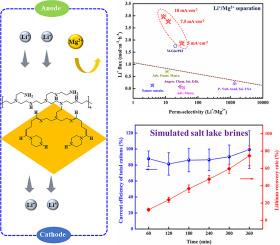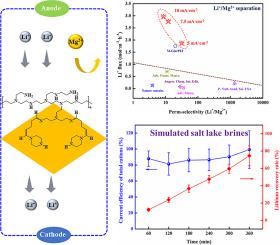通过烯胺反应提高选择性电渗析膜的锂镁分离性能
IF 11.4
1区 环境科学与生态学
Q1 ENGINEERING, ENVIRONMENTAL
引用次数: 0
摘要
单价阳离子交换膜(MCEM)在离子分离领域逐渐发挥了重要作用。然而,根据过渡态理论(TST),同步调节阳离子传输的焓障(△H)和熵障(△S)以提高离子分离性能是一项挑战。在这里,-NH- 和 -CHO 基团之间的烯胺反应被用来调节随后的 -CHO 和 -NH2 基团之间的希夫碱反应,从而减少了选择层的正电荷,但增加了立体阻碍。阳离子迁移的 -T△S(△S 项)的增加在提高 Li+/Mg2+ 分离性能方面发挥了重要作用。最佳正电荷戊二醛@哌嗪/聚乙烯亚胺组装膜(M-Glu@PIP/PEI)的过选择性(Li+/Mg2+)为 31.83,Li+通量为 1.87 mol-m-2-h-1,超过了最先进的单价离子选择性膜(MISM)的 Li+/Mg2+ 分离性能。最重要的是,采用 M-Glu@PIP/PEI 的选择性电渗析(S-ED)工艺可直接用于处理模拟盐湖卤水(SLBs),其卓越的 Li+/Mg2+ 分离性能和运行稳定性可回收 74.44% 的锂资源,Li+纯度为 34.02%。这项研究为设计高性能 MCEM 以实现高能效资源回收提出了新的见解。本文章由计算机程序翻译,如有差异,请以英文原文为准。


Boosting lithium/magnesium separation performance of selective electrodialysis membranes regulated by enamine reaction
Monovalent cation exchange membranes (MCEMs) have progressively played an important role in the field of ion separation. However, according to transition state theory (TST), synchronously tuning the enthalpy barrier (△H) and entropy barrier (△S) for cation transport to improve ion separation performance is challenging. Here, the enamine reaction between the -NH- and -CHO groups is applied to regulate the subsequent Schiff-base reaction between the -CHO and -NH2 groups, which reduces the positive charges of the selective layer but increases the steric hindrance. The increased -T△S (△S term) for cation transport plays an important role in improving Li+/Mg2+ separation performance. The optimal positively-charged glutaraldehyde@piperazine/polyethyleneimine assembled membrane (M-Glu@PIP/PEI) has a perm-selectivity (Li+/Mg2+) of 31.83 with a Li+ flux of 1.87 mol·m-2·h-1, surpassing the Li+/Mg2+ separation performance of state-of-the-art monovalent ion selective membranes (MISMs). Most importantly, the selective electrodialysis (S-ED) process with M-Glu@PIP/PEI can be directly applied to treat simulated salt-lake brines (SLBs), and its superior Li+/Mg2+ separation performance and operational stability enables 74.44 % of the lithium resources with a Li+ purity of 34.02 % to be recovered. This study presents new insights into the design of high-performance MCEMs for energy-efficient resource recovery.
求助全文
通过发布文献求助,成功后即可免费获取论文全文。
去求助
来源期刊

Water Research
环境科学-工程:环境
CiteScore
20.80
自引率
9.40%
发文量
1307
审稿时长
38 days
期刊介绍:
Water Research, along with its open access companion journal Water Research X, serves as a platform for publishing original research papers covering various aspects of the science and technology related to the anthropogenic water cycle, water quality, and its management worldwide. The audience targeted by the journal comprises biologists, chemical engineers, chemists, civil engineers, environmental engineers, limnologists, and microbiologists. The scope of the journal include:
•Treatment processes for water and wastewaters (municipal, agricultural, industrial, and on-site treatment), including resource recovery and residuals management;
•Urban hydrology including sewer systems, stormwater management, and green infrastructure;
•Drinking water treatment and distribution;
•Potable and non-potable water reuse;
•Sanitation, public health, and risk assessment;
•Anaerobic digestion, solid and hazardous waste management, including source characterization and the effects and control of leachates and gaseous emissions;
•Contaminants (chemical, microbial, anthropogenic particles such as nanoparticles or microplastics) and related water quality sensing, monitoring, fate, and assessment;
•Anthropogenic impacts on inland, tidal, coastal and urban waters, focusing on surface and ground waters, and point and non-point sources of pollution;
•Environmental restoration, linked to surface water, groundwater and groundwater remediation;
•Analysis of the interfaces between sediments and water, and between water and atmosphere, focusing specifically on anthropogenic impacts;
•Mathematical modelling, systems analysis, machine learning, and beneficial use of big data related to the anthropogenic water cycle;
•Socio-economic, policy, and regulations studies.
 求助内容:
求助内容: 应助结果提醒方式:
应助结果提醒方式:


